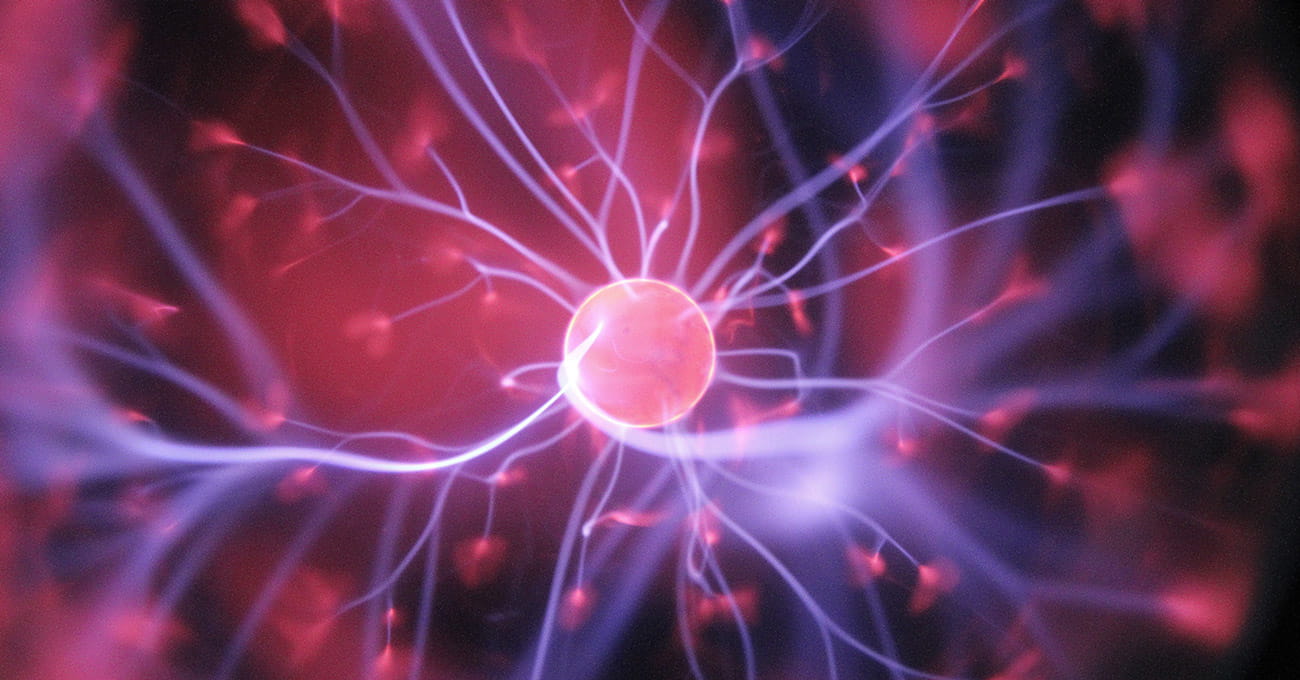The Health Effects of EMFs: How to Protect Yourself From the Dangers of Electromagnetic Radiation
BY ANN LOUISE GITTLEMAN
 photo: hal gatewood
photo: hal gatewood
Let’s take a trip back in time, and then do some fast-forwarding—to give you some idea of the way our technology has grown over the past fifty years and why we’re so overexposed to electromagnetic fields (EMFs) and their potential dangers.
If you’re forty or older, close your eyes and think back to your childhood home. If you’re under forty, think back to your grandparents’ house when you were a kid.
Now take yourself on a mental tour of the house. As you walk from room to room, take a quick visual inventory in your mind of how many electric and electronic appliances and gadgets you see.
If your family was typical, here’s what you’ll likely come up with:
+ Master bedroom: A clock-radio or alarm clock, unless it’s a windup clock
+ Bedroom #2: A clock-radio or alarm clock, unless it’s a windup clock
+ Bedroom #3: A clock-radio or alarm clock, unless it’s a windup clock
+ Bathrooms: No appliances, or maybe an electric razor
+ Family room: A TV, a stereo (maybe), phone
+ Living room: No appliances
+ Kitchen: Stove, refrigerator, dishwasher (maybe), blender, can opener, electric knife, toaster, phone
+ Total inventory: 15
And if you were to take a similar tour of your own home today?
+ Master bedroom: TV, TiVo, cable box, DVD player, remote control for TV, remote control for TiVo, remote control for cable box, remote control for DVD player, cell phone, cell phone charger, iPad, iPad charger, Bluetooth headset, Bluetooth headset charger, computer, monitor, wireless mouse, wireless keyboard, printer, scanner, air purifier, alarm clock, cordless phone
+ Bedroom #2: TV, TiVo, cable box, DVD player, remote control for TV, remote control for TiVo, remote control for cable box, remote control for DVD player, cell phone, cell phone charger, iPad, iPad charger, Bluetooth headset, Bluetooth headset charger, laptop, alarm clock, cordless phone
+ Bedroom #3: TV, TiVo, cable box, DVD player, remote control for TV, remote control for TiVo, remote control for cable box, remote control for DVD player, cell phone, cell phone charger, iPad, iPad charger, Bluetooth headset, Bluetooth headset charger, laptop, alarm clock, cordless phone
+ Bathrooms: Rechargeable electric toothbrush, rechargeable electric razor, curling iron, hair dryer, digital scale/body fat monitor
+ Family room: Home theater system (including monster-size flat-panel TV, TiVo, cable box, DVD player, surround-sound speaker system), remote control for TV, remote control for TiVo, remote control for cable box, remote control for DVD player, remote control for speaker system, computer, monitor, wireless mouse, wireless keyboard, printer, scanner, digital thermostat, cordless phone, wireless router
+ Living room: Digital picture frame, cordless phone, wireless security system
+ Kitchen: Stove, refrigerator, microwave, dishwasher, blender, toaster oven, food processor, wall-mounted security system panel, coffeemaker or espresso machine (or both), water filtration system, cordless phone, rechargeable flashlight, rechargeable mini-vac
+ Total inventory: Over 100
So what’s really going on here? We’re getting zapped.
If you pay close attention to your activities for just one typical day, you’ll quickly realize that a new form of invisible pollution is all around you and, as you’ll learn, within you, twenty-four hours a day, seven days a week. Granted, you probably don’t have all those electronic gizmos in your house, and not all of these modern-day wonders are emitting dangerous EMF radiation. Plus, let’s face it, how much time do you spend sitting in front of your electric coffeemaker anyway? How long you’re exposed to EMF dangers often means more to your health than the actual strength of the electrical, magnetic, or radio frequency (RF) field. But I used this long list to give you some idea of how much life has changed in the digital age—and how many more electromagnetic fields we’re exposed to than our grandparents were.
Think about what you did today and what electromagnetic radiation dangers you may have been exposed to: Perhaps you woke to the smell of coffee brewed exactly the way you like it by your electric coffeemaker, which you set on a timer the night before. Maybe you went downstairs, flicked on the fluorescent lights in the kitchen, pulled a frozen breakfast out of the refrigerator, popped it into the microwave, and sipped your first cup of coffee while you waited for it to heat. If you couldn’t wait until you got to the office, you pulled your smartphone or cell phone out of its holster and checked your e-mail and then pulled up local traffic and weather reports. And after all of this, you took a hot shower and were thrilled that the new water heater let you take a long, luxurious one.
You might have taken an electric train or subway to work. If you drove, you probably paid no attention to the power lines strung on the ubiquitous wooden poles that are as much a part of the landscape as trees, or the huge transmission poles lumbering across the countryside like sci-fi giants. If you happened to glance over at the car or passenger next to you, you likely saw someone else, like you, on a cell phone, starting the business day before it officially opens. At work, you might walk through an automatic door, take an elevator to your office, flick on the overhead lights, and boot up your computer.
Then, at the end of the day, you reverse it all. Maybe you stop at the supermarket on your way home and buy a few things for dinner, which the checker whisks through a price scanner and tosses in a bag for you. If you’re cooking from scratch, you preheat your electric oven, defrost the chicken in the microwave, and put it in to bake. You’ll mash the potatoes you boiled on the range with your electric mixer and open the canned green beans with an electric can opener.
Maybe you’ll sit in a comfortable automated massage chair before you finish up a report on your laptop computer, or huddle with your eight-year-old while he does his homework and then challenges you to an online game of Scrabble. You might watch a little satellite TV before climbing into bed, where you root around for the remote that controls the firmness or angle of your mattress.
Everything you did, from making coffee to taking a shower to taking the train to buying groceries to going to bed, exposed you in some small or large way to the adverse health effects and dangers of EMFs, which are invisible force fields that surround all electrical devices. For many people, these invisible energy fields appear to be benign. They have no symptoms—at least, none that they recognize. But others seem acutely attuned to what others can’t see, touch, or feel.
From Electricity to Electropollution
The widespread use of the light bulb—one of the most life-changing events in the past ten thousand years—was how it all began. In October 1882, Thomas Edison built the first electrical plant that lit just thirteen hundred street lamps and homes in New York City. What followed was an unprecedented avalanche of inventions that harnessed electric power to make Americans more productive and prosperous, as well as safer and healthier, than ever before. In just the first half of the twentieth century, Americans were introduced to everything from conveyor belts, printing presses, electrocardiograms, and X-ray machines to radio, radar, television, and computers.
In the last fifteen years alone, the latest modern electronic wonder—wireless technology—has expanded like a sponge in water, as have the potential health effects and dangers of electromagnetic radiation. Today, 84% of Americans own cell phones, and the wireless industry is expected to become a larger sector of the U.S. economy than agriculture and automobiles. About 89 million of us watch TV shows beamed to us by satellite—sports, music, comedy, and drama captured by a metal dish on the roof or outside a high-rise window. And you can’t have a cup of coffee at Starbucks without being subject to Wi-Fi, the wireless network that allows you to surf the Internet as you sip your latte.
Yet we may not understand the potential EMF health effects and consequences of our latest discoveries any better than our earliest ancestors understood the perils of fire.
For the last ten years in my clinical practice as a researcher, author, and educator, I have been seeing a strange constellation of EMF exposure symptoms in my clients that defy diagnosis and resist even the most tailor-made diet, evidence-based supplementation, state-of-the-art exercise, clinical testing, or even significant lifestyle changes. Consider these very different, but equally puzzling, case histories:
+ Fresh out of college, a newlywed moves with her husband to what ought to be the healthiest place in the world—a farm in America’s heartland. Yet within six months, this 23-year-old has become so weak, she can barely walk up the stairs. She has developed daily headaches, circulation problems, and hot flashes. She wakes up every morning feeling like she has been “hit by a Mack truck and then run over by a train.” Her doctor tells her she has chronic fatigue syndrome.
+ While on the job, an emergency room physician suffers from blinding headaches, dizziness, and muscle weakness that make it impossible for her to intubate a patient or even smile for a photo. At one point, her arms and legs turn blue, her vision begins to fade, and her heart begins to squeeze “as if it was empty.” One doctor diagnoses her as mentally ill.
+ Out of the blue, a high-powered editor, who has been commuting for years to her New York office by train, suddenly begins to feel nauseous during every morning and evening ride. She blames it on stress, but it’s becoming so debilitating, she considers quitting the job she loves.
+ The parents of a young Wall Street trader—who spends most of his working day with a cell phone stuck in each of his ears—are concerned as his health declines over a three-year period, during which he is diagnosed with a host of conditions including autoimmune disorder, parasites, and mercury toxicity.
+ A recent engineering school graduate working for the Canadian Navy experiences fatigue so severe, he needs to take naps on his lunch hours. As time goes on, he develops chronic respiratory infections, nausea, digestive distress, heart palpitations, and trouble focusing. His diagnosis: stress.
+ A normally well-behaved 13-year-old boy who is doing well in school suddenly develops a behavior problem. Oddly enough, he only acts out at a specific time each day, which mystifies his parents and doctors.
Unraveling the Mystery of EMF Health Effects
In the past decade, I have experienced some of these same baffling symptoms for which I too found no relief. In 2005, I was diagnosed with a (thankfully) benign tumor of the parotid, one of the salivary glands located just below the earlobe. Why I got it was a mystery that puzzled even my doctor. It’s a very rare tumor, most often caused by radiation exposure. I didn’t live near a nuclear plant, I hadn’t been exposed to an inordinate number of medical X-rays or other screening tests, and, except for a brief time I spent working as a nutritionist in a hospital, I hadn’t even been near a CAT scanner or MRI machine. But, on a hunch, I began my investigations with a theory: What if what these six people and I were suffering from was an environmental condition, one caused by something we’re exposed to every day but consider harmless?
There are several historical connections that supported my suspicions of electromagnetic radiation dangers. Many well-respected historians believe that the Romans were the first society to be destroyed by environmental toxicity. Wealthy Romans painted their walls with lead-based paint. They used the heavy metal for everything: water pipes, toys, statues, cosmetics, coffins, and roofs. But in an article written for The New England Journal of Medicine, lead poisoning researcher Jerome Nriagu, Ph.D., D.Sc., an environmental chemist at the University of Michigan, says that it was their consumption of copious amounts of wine that may have given them their heaviest dose.
The Romans flavored their wine by simmering the grape juice in lead pots or lead-lined copper kettles, which not only affected taste but made the wine last longer. Lead has a sweet taste, so it enhanced the sweetness of the wine—which earned the metal the reputation as the sweet poison. The acidic nature of the grapes extracted large amounts of lead from the utensils, and then the Romans quaffed the drink out of lead cups. They may have been taking in as much as 20mg of lead a day just from wine alone, enough to cause chronic lead poisoning, diminish fertility, and cause mental and emotional impairments.
After more than a year of research, I’ve come to the conclusion that we, like the ancient Romans, are being exposed to an invisible type of “new” pollution that is making our life “sweeter”—certainly more convenient—but which comes with formidable and unforeseen side effects.
It’s called electropollution. It’s odorless, colorless, and invisible, and it’s probably enveloping you right now. As writer Sara Shannon writes in her 1993 book, Technology’s Curse: Diet for the Atomic Age, about low-level electromagnetic radiation dangers: “It cannot be seen, felt or heard. It is tasteless and odorless. It is in our food and in the air; it is in our blood and in our bones and can remain in our ashes to go on to contaminate someone else.”
Our “sweet poison” is the EMF dangers produced by our cell phones, wireless networks, cell and broadcast towers, power lines, fluorescent lights, even the electrical systems that power our appliances, TVs, computers, and bedside alarm clocks—all those technological devices that make our lives easier. We are affected 24/7 by an unprecedented number of frequencies and wavelengths. By some estimates, we’re exposed daily to as much as 100 million times more EMF radiation than our grandparents were. It flows around us, in us, and interferes with the body’s fundamental electric forces of life, including the communication between our cells that tells them how to grow, develop, divide, and even when to die.
Remember those six people I just told you about? They ultimately unraveled the root cause of their mysterious ailments, as I did. They had been zapped.
+ The newlywed’s symptoms were finally traced to a current of electricity that was traveling along the ground and hitchhiked into her home via her own electrical system and water pipes.
+ The ER doctor, exposed to toxic mold in her home, had developed multiple sensitivities to common everyday chemicals an EMF sensitivity.
+ The editor discovered by accident that if she sat every morning in the train’s designated quiet car, away from the cell phones, BlackBerrys, and laptops of her fellow commuters, her EMF exposure symptoms disappeared.
+ After months of research, the 13-year-old’s mother found that his sudden behavioral changes coincided with a radar beam sweep of their home from a nearby naval station. The family moved away from the radar beam and the young man’s behavioral problems disappeared.
+ The Wall Street trader was forced to quit his lucrative job to get away from the buzzing hive of techno-gizmos on the trading floor. Today, he may make less money, but he’s also symptom-free.
+ The engineer was able to stay in his job because his employer—the Canadian government—provided him a shielded office to provide EMF protection for him from the radar and other devices that caused his chronic illness.
In my case, years tethered to a computer and cell phone while writing a myriad of books and promoting them on the road had sensitized me to the very tools I depended upon for my career. My parotid tumor turned out to be one of several kinds of tumors linked to cell phone use—and I developed it after several years of traveling constantly and literally living on my cell phone in cars, trains, and planes, unknowingly exposing myself to the dangers of EMFs.

While I haven’t given up my cell phone or my computer, you won’t find me spending hours on either of them. I’ve learned to work around—and live well and happily with—modern-day technology.
Why Do I Feel This Way?
Perhaps you have strange symptoms, like the people I’ve described here, and wonder if they might be EMF or radiation symptoms. Perhaps you’ve wondered about the health effects of EMFs and radiation. Perhaps you’ve suspected all along that modern-day maladies like sleeplessness, chronic fatigue syndrome, fibromyalgia, depression, anxiety, and rising rates of cancers and brain tumors, particularly in young people, may have an underlying environmental cause. One eminent researcher has already made that connection. Samuel Milham, M.D., M.P.H., of the Washington State Department of Health, wrote in the journal Medical Hypotheses in 2009 that he traced the rise in degenerative disease, cardiovascular disease, and suicide in the United States to the spread of electrical power to urban and rural areas, which was completed around 1956. He compared government disease and mortality statistics before and after electrification and found what is, in essence, the tipping point. When agricultural areas became electrified, rates of these lifestyle diseases started to match that of urban areas, where electricity was introduced in the late 1800s.
“I hypothesize that the 20th-century epidemic of the so-called diseases of civilization, including cardiovascular disease, cancer and diabetes, and suicide was caused by electrification not by lifestyle,” writes Milham. “A large proportion of these diseases may therefore be preventable.” I agree that they are preventable. If you had enough curiosity to start reading this in the first place, then I’ll bet you have the courage to be proactive, powered by the knowledge to take the necessary steps to start and EMF protection protocol and become healthier, happier, and to regain your peace of mind.
Allergic to the Digital World
How have we become allergic to a force that has been with us since time began? Even if you could turn back the hands of time to before 1882 when Edison’s electric plant triggered a social, scientific, and industrial revolution, you would still have been exposed to electromagnetic energy but not necessarily to EMF dangers.
We, and the universe we live in, produce and operate in a sea of both natural and unnatural electrical and magnetic fields. The earth, for example, pulses at about 10 Hz, like a small engine. Our bodies are really electromagnetic machines.
We simply can’t move a muscle or produce a thought without an electrical impulse—and wherever there is electricity, a magnetic field is also produced, which is why we link the two together into one word: electromagnetic.
Over eons, our bodies have grown accustomed to the low energy of those natural electromagnetic fields and the wavelengths and frequencies they produce. In fact, they play a positive and important role in all life on earth. Humans have lost most if not all of our awareness of it, but animals still dance to its silent orchestrations. You can see it in their behavior and their ability to foretell earthquakes, hurricanes, and tsunamis—not through any supernatural power but by their acute sensitivity to the earth’s electromagnetic hum and electrostatic charges in the air. You can see it in the migratory patterns of birds and animals who seem to be innately directed with some unknown internal antenna.
Many scientists now suspect the secret of their mysterious know-how may be magnetite, a mineral that is a million times more magnetic than iron and is found in the tissue of every living thing: in the eye area of birds, the lines on the bodies of fish, the teeth of sea mollusks, and the abdomens of bees. It links them to the electromagnetic fields of the earth, keeping them plugged in, so to speak, to the earth’s energy.
And it’s in us too. Small amounts of this magnetic substance are also found in the brain tissue, blood-brain barrier, and the bone above the eyes and sinuses of humans. What effect this internal compass has in us is unknown. We do know that there is a very narrow range of electromagnetic frequencies to which the brain cells of animals and humans respond favorably, and it roughly matches the frequencies produced by the electromagnetic fields produced naturally by our world, but at what point do we need to consider electromagnetic radiation dangers?
What we are also beginning to understand is the EMF health effects that the proliferation of technology, while it has taken us many strides in social and economic progress, may have finally created a toxic load that is too great for some bodies to handle, just as the rapid rise of toxic chemicals such as pesticides, plastics, and heavy metals in the environment has overwhelmed the ability of some bodies to neutralize them In fact, many experts believe, like I do, that these invisible fields are contributing to making us sick. I am totally convinced that they made me sick.
Coming to Terms
The language of electromagnetic fields, much of it from physics, is difficult to navigate, so I’ve tried to minimize my use of jargon. However, there are certain terms, particularly related to the measurement of electric, magnetic, and radio frequency fields, that are impossible to avoid. Here are a few simple definitions that you need to know:
Wave/Wavelength: Electricity is delivered to our homes in alternating current (AC), which means that the electrical charge that flows through the wires periodically reverses direction (cycle), and it’s usually shown as an undulating wave, called a sine wave. Wavelength is the measurement of the distance between two peaks of the wave.
Frequency: How many cycles a wave completes in a period of time is known as its frequency. If you live in North America, electrical currents flow to your wires at 60 cycles a second; in Europe, it’s 50 cycles a second. This is termed alternating current, or AC for short.
Gauss: This is the measurement unit for magnetic fields. Most prudent scientists today recommend that safe exposure for humans to an AC magnetic field is 1 milliGauss (mG) or less at any single exposure, though other agencies recommend 2 to 3 mG. The earth’s magnetic field measures about 0.5 mG.
Hertz: This is a newer term for cycles per second that was awarded to Heinrich Hertz, an early researcher in electromagnetism. The electricity that comes into U.S. homes is 60 Hertz (Hz). Our brainwaves can even be measured in Hertz. For instance, when you are asleep, your brain hums at 1 Hz, or one cycle per second. When you’re thinking, whether it is problem solving or being creative—it revs up to as much as 40 Hz.
Extremely Low Frequency Electromagnetic Fields (ELF): These are the electromagnetic fields in the frequency range of 1 to 30 Hz. Our entire electrical power system and our appliances produce 60 Hz magnetic and electric fields. These fields are a form of non-ionizing radiation, which won’t detach electrons from atoms or molecules. Only ionizing radiation or energy from radioactive substances and cosmic rays are thought to do that: The X-ray you had at the dentist’s office and the CAT scan (which uses X-rays) that found your kidney stone both emit ionizing radiation.
Radio Frequency (RF) Field: Another form of non-ionizing radiation, these high frequency EMFs are generated by the equipment that transmits wireless signals, such as cell towers, broadcast towers at your local radio or TV stations, and the equipment that receive those signals—your cell or cordless phone. Wireless operates in the microwave band of radio frequency radiation.
Why We Get Zapped
Why are we so vulnerable to EMF dangers and health effects? The human body, which is 75% water, conducts electricity. It’s also an effective antenna that picks up energy from the surrounding environment. If you’ve ever adjusted TV rabbit ears, you know that just the touch of your hand can bring in a better picture. That’s because at that moment, the RF waves carrying the image are broadcasting them to you. For that moment, you are the antenna.
In fact, humans are literally walking conversations, cells chattering to one another and interacting with the natural world using electrical charges and chemicals to make the connections. But when you add artificial electromagnetic forces to the mix, we are starting to learn, these quiet conversations suddenly become cacophony, as though a flash mob has arrived, shouting and screaming and with boom boxes blaring so loudly you can’t hear yourself think. And, in essence, that’s exactly what happens when you’re exposed to the ever-expanding web of electromagnetic forces of varying sizes and strengths that our bodies aren’t used to and lack EMF protection against.
Humans have as little protection from this kind of pollution as we do for toxic chemicals, though we do have some. For example, the voltage from low-level electrical fields, a form of ELFs, produced by your appliances or overhead power lines, have a limited ability to penetrate the body. Your cell membranes block electrical fields, though not completely.
But your body will pick up whatever electrical field you’re exposed to, even if it’s just the 60 Hz field of your electric shaver or hair dryer; the magnetic field that accompanies it is absorbed entirely and can sometimes pose electromagnetic radiation dangers. As New York Times writer B. Blake Levitt points out in her landmark book Electromagnetic Fields: A Consumer’s Guide to the Issues and How to Protect Ourselves, this may disrupt your internal electrical field as well as interact with magnetic metals like iron and copper and charged particles in your blood to affect your health in still little-known ways.
Cells, Interrupted
So what might happen when your own electromagnetic field encounters one outside your body, one that’s louder than the ambient levels with which we have evolved? For one thing, it may interfere with the messages your body’s cells send and receive—what the late scientist W. Ross Adey, M.D., of the Pettis Memorial Veterans Administration Hospital in Loma Linda, California, referred to as “whispers between cells.” In his experiments, Adey, who chaired the National Council on Radiation Committee on Extremely Low Frequency Electromagnetic Fields, found that both very low frequency fields, such as those produced by our electrical system, as well as the higher radio frequencies utilized by cell phone and broadcast towers may interrupt that cellular chatter or drown out the electrical impulse that carries messages across the cell membranes.
You’ve probably had the experience of losing a radio station or even picking up another when you drive under a high voltage line or near broadcast towers. Likewise, your cells, exposed to the same electromagnetic forces, may drop their conversation with one another or pick up outside interference that could muddle their messages. It’s one thing to miss the chorus of your favorite song, another to have an important thought—watch out for that car—get lost in translation because brain cells become confused.
Electromagnetic Science—What Happens in Your Body
Here’s a little bit of the science of what happens when you’re overexposed to EMFs (and a glimpse into potential EMF radiation health effects):
Your cells get overwhelmed by messages from inside and outside your body.
One way these artificial fields may disrupt normal electrochemical communication and pose an EMF danger is by increasing the number of what are called receptors on the surface of your cells. Receptors are often described as a keyhole into which the key—a chemical messenger called a neurotransmitter—fits perfectly to open the cell, allowing outside information from your brain or other parts of your body to get inside. These receptors and neurotransmitters help transfer those messages from one cell to the other, like a game of Whisper down the Lane, but without the garbled transmission.
For example, if you’re sick or injured, you want your cells to send out an SOS to your immune system so healing starts right away. And if you’re otherwise healthy, that’s what happens. The number of receptors you have varies widely, and some cells have so many that they’re likely to attract more activity than those with fewer receptors.
If overexposure to EMFs boosts receptor numbers, more of your cells become increasingly open to all kinds of messages from your body and from the environment outside. Suddenly, while trying to send its vital 911 call to your immune system, your cells start listening to and responding to other voices and directions. It’s like an old-fashioned party line—too many callers talking so the wrong messages—or no messages at all—get through.
Your cells become unglued.
Provocative new research has uncovered another health effect of EMFs involving the way cellular transmission is interrupted. Studies have found that even low-level EMFs may rupture delicate cell membranes, releasing calcium from cells as well as changing the way calcium ions—electrically charged calcium atoms—bind to the surface of the membrane. For example, Adey and his colleagues found that exposing newly hatched chicks to a 16 Hz frequency caused their brain cells to leak calcium ions. Since calcium ions are the glue that holds together cell membranes, which are only two molecules thick, the membranes are likely to weaken and tear, allowing toxins to enter and contents to spill out. They literally become unglued.
Obviously your cells need some calcium. There’s even a natural system in place to make sure they get the right dose. But what happens when there’s a flood of calcium ions from a torn membrane in the main part of the cell? It depends on what your cells are doing at the time. If you’re sick or injured, your cells are in the process of healing you, so these extra calcium ions help speed the process.
When calcium ions pour into one or more of your one hundred billion brain cells, which use calcium in small doses to make neurotransmitters, they may release those chemical messengers too soon, too often, or at the wrong time, creating false messages that tell you that you’re in pain or bring on neurological symptoms, such as headaches, an altered sense of taste or smell, tingling, or numbness. Those are just a few of the EMF exposure symptoms experienced by the people we just met and part of a collection of problems experienced by people who are hypersensitive to EMFs.
Too many calcium ions in your brain cells may also impair your lifesaving ability to assess a situation correctly—like when you’re at the wheel of a car. Noted British scientist Andrew Goldsworthy, Ph.D., honorary lecturer at Imperial College of London, suspects that the increase in accidents among cell phone users (in one in four crashes, a driver is on a call) has less to do with distraction than with delayed response caused by the flood of calcium ions into brain cells. This flood creates what he calls “a mental fog” of false information, obscuring the ability to react to, say, a child on a bike pulling out between two cars or a deer bounding from the woods at twilight. After all, we’re often distracted at the wheel when we’re talking with a passenger, listening to a radio talk show, or engrossed in an audio book, none of which have been linked to increased accident risk. There’s obviously something more, something physical related to phone use.
And, in fact, a study of young adults aged 12 to 14 in Australia found that those who used their cell phones the most suffered from poor memory and delayed reaction time—yes, even when they weren’t on the phone, raising awareness and concern for the dangers of EMFs on youth.
Chemicals pouring from your ruptured cells damage your cellular DNA.
Our bodies have an amazing defense system. Just as cell membranes offer some EMF protection (though not enough), a healthy cell membrane will also self-heal. But, before it repairs the tear, it may release a digestive enzyme called DNAase, which can destroy or damage DNA, potentially turning your genetic material into a precursor to disease by altering its important directions on how and when to grow, divide, and die. Studies using cell phone signals have found evidence of just that effect. For instance, in one Greek study of EMF dangers on fruit flies, whose short life span makes them the perfect subject for basic genetic research, researchers found that exposure to mobile phone signals for only six minutes a day for six days actually fragmented the genetic material in the cells that produced the flies’ eggs, and half of the eggs died.
EMFs may disrupt normal cell division.
Electromagnetic fields may strike danger at cellular DNA in other ways too. Scientific research has found that exposure to ELFs, for example, speeds up cell division and reproduction. During the cell division process, known as mitosis, DNA is reproduced, chromosomes line up in pairs, and then pull apart to create a daughter cell that should be the spitting image of its mother. Exposing cells to ELF disrupts that orderly process of chromosome matching and detaching, so that the two new cells don’t get equal amounts of the genetic information. This can result in scrambled messages. The consequence? Damage to fertility or a developing fetus.
EMFs create oxidative stress that further damages DNA and other physical processes.
Evidence from animal studies suggests that exposure to the level of electromagnetic force that’s produced by something as mundane as your refrigerator may create free radicals, unpredictable molecules whose unpaired electrons seek to attach themselves to electrons in other molecules. Those most fundamental things we do—breathing and eating—cause our body to react with oxygen. It’s perfectly normal. But it’s a process that can go awry. When metal becomes oxidized, for example, it develops rust. When you slice open an apple and leave it in the air, it turns brown. Oxidation can turn fats rancid, which is why you’re advised to keep oils tightly sealed and in a cool, dark place. The same thing happens in your body. Fat becomes rancid—scientists call it lipid peroxidation, and it sets your cardiovascular system up for the buildup of hardened lumps of fat and other debris on your arteries. Those clogs can cause heart attacks and strokes. Free radicals contribute to arthritis by oxidizing joint fluid, making it less lubricating. They can cause DNA damage to your cells, making cell membranes so rigid that nutrients can’t get in and ultimately make the cell so fragile it breaks, allowing toxins to come in and fluid to drain out before it finally collapses. This process is considered the root cause of aging and disease, from cancer to Alzheimer’s. At the University of Washington, scientists Henry Lai and Narendra P. Singh found that free radical creation at a 60 Hz alternating current—typically found in homes that have no wiring problems and are not located near power lines—caused breaks in the DNA of brain cells of rats exposed for only 24 to 48 hours. The rest of us are exposed 24/7.
Science Takes Notice
The evidence is accumulating regarding the dangers and health effects of EMFs. One of the first studies linking magnetic fields from power lines to adverse effects on human health was published in 1979 by two Denver researchers, the late Nancy Wertheimer, Ph.D., and physicist Ed Leeper. Based on Wertheimer’s field studies of childhood cancers in the Denver-Boulder area, the two reported that children who lived one or two houses from what are called step-down transformers (the barrel-shaped devices mounted on the power poles in your neighborhood) had a two-to-three-fold increase in childhood cancers, specifically leukemia and brain tumors. In 1986, a similar study conducted at the University of North Carolina, Chapel Hill, confirmed their findings.
Although a number of studies regarding EMF radiation and health effects since have disputed the leukemia-EMF link, there have been at least 30 studies not only confirming the original 1979 work, but expanding on it to associate transmission power lines, hair dryers, common household appliances, video games, and microwave ovens to children’s cancers.
In fact, David Carpenter, M.D., dean of the School of Public Health at the State University of New York, has been quoted as saying that he believes up to 30% of childhood cancers stem from EMF exposure. And it doesn’t take much EMF radiation. In several of these studies, the risk was elevated when children lived near magnetic fields that were 1,000 times lower than the existing safe exposure limit established by the International Commission on Non-Ionizing Radiation Protection.
Since the Leeper-Wertheimer study, hundreds of studies have found that exposure to magnetic fields (EMFs) may be associated with a variety of conditions, including Alzheimer’s disease, heart disease, amyotrophic lateral sclerosis (ALS, or Lou Gehrig’s disease), heart disease, miscarriage, birth defects, infertility, and mood disturbances such as depression.
To add to this, some experts are now saying that proliferating technology is overburdening our aging electrical infrastructure, exposing us to high frequency EMFs in our homes, offices, and schools. Surges of high frequency voltage or electromagnetic radiation from radio waves, currents that run along grounded lines or water pipes, or high frequency spikes and harmonics (distortions in the current or wave) from our appliances and other electronic sources are contaminating the low frequency lines, creating a hybrid now being called “dirty” electricity.
Studies suggest these “freaky” frequencies may be the cause of sick building syndrome—a constellation of EMF exposure symptoms including headaches, allergies, fatigue, skin irritation, depressed mood, and disruptive behavior in children—and some cases of attention deficit disorder (ADD). There’s also evidence that it may raise blood sugar in diabetics and increase symptoms in those with multiple sclerosis.
The List Goes On
In just the past five years, new research has painted a more detailed picture of the health and environmental effects of electromagnetic pollution. Here are just a few highlights from the hundreds of studies I’ve reviewed regarding EMF radiation health effects:
+ In 2006, a study of the cell phone habits of 900 people with brain tumors, conducted by the Swedish National Institute for Working Life, found that those who used cell phones for 2,000 cumulative hours had a 240% increased risk for a malignant tumor on the side of the head where they usually held the phone. Two years later, Israeli researchers found that those people who kept their cell phone against one side of their head for several hours a day were 50% more likely to develop a rare salivary gland tumor on that side (just like mine).
+ A study published in the journal Epidemiology in July 2008 reported that children born to mothers who used cell phones while pregnant and whose children used cell phones by age seven were 80% more likely to be hyperactive and to have emotional and behavioral problems.
+ Many studies have found that EMFs can interfere in the body’s nighttime production of the hormone melatonin, which is vitally important for sleep and the lack of which can impair immunity.
+ Other studies and personal reports of the dangers and health effects of EMFs link even minimal EMF exposure to sleep disturbances, immune-system suppression, brain wave changes, headaches, light sensitivity, heart arrhythmias, chronic fatigue, memory problems, ringing in the ears, depression—associated with a new problem, called electrosensitivity.
+ There has also been some evidence that EMFs may contribute to some of the leading environmental issues of our time. German studies suggest that the destruction of forests (in Germany and in the western United States) once blamed on acid rain may actually be the result of constant bombardment from 60 Hz power lines and the RF waves from communications equipment. And some researchers suspect that electropollution may be in part responsible for the changing weather patterns now blamed on global warming.
The Exception that Proves the Rule
To be perfectly honest, many scientists still regard the low-level fields and the high-level radio waves to which we’re exposed to be entirely benign. They argue that these are fairly weak fields that diminish rapidly the farther away you get from them. And many studies have looked at the same data and have not shown the same effects.
A group of top international scientists, writing in the 2007 BioInitiative Report, which called for further examination of EMFs and their effect on public health, were clear: conflicting studies should not be taken as an “all clear.” In fact, they note, “there should be no effect at all if it were true that EMF is too weak to cause damage.” And if EMFs had no substantial effect on the human body, the report says, then their use as therapeutic tools would be little more than quackery.
It’s true. Mainstream medicine harnesses the power of EMFs to heal. It seems like the ultimate paradox. Broken bones are mended and wounds healed by pulsed EMF stimulation; pain is eased by transcutaneous electrical nerve stimulation (TENS), the application of electricity that appears to activate the body’s own pain-relieving (opioid) system; and depression is lifted by transcranial magnetic stimulation, which uses weak electrical currents and rapidly varying magnetic fields to excite brain nerve cells.
Currently being tested on humans is the use of low-intensity EMFs to literally jiggle the electrically charged particles in cells hundreds of thousands of times per second, which can disrupt the division of cancer cells, preventing them from spreading. Israeli researchers studied ten people with glioblastoma multiforme—the same deadly form of brain cancer that killed Senator Edward Kennedy. Those who received the low-intensity EMF therapy lived longer—median survival rate: 62 weeks—than most people with the disease, which usually results in death within 12 months of diagnosis.
And yet, in the midst of all this gloom and doom, there are real glimmers of hope and true healing, as you will find out shortly. There are positive ways to reduce the negative influences and health effects of EMFs without giving up the comfort and conveniences of modern-day living.
Living with Technology
At this point, you may be doing what I did while researching this—making a mental list of every electronic device you own and assessing which ones you could live without, or maybe you’re planning your move to a relatively remote part of the globe. The truth is that some technologies do present a clear and present danger. There are hundreds of reliable independent studies that say so. But there are also ways of mitigating their effects safely and practically—which is what my book Zapped is all about. We may not know the exact extent to which EMFs pose a threat, but we do know the ways in which the technologies that generate them benefit us. So living safely with technology is definitely a balancing act. You will have to intervene in your own living situation. You don’t have to do without electric lights, satellite TV, your microwave, or cell phone, as long as you are reducing exposure, prudently avoiding overuse, and implementing some of the cutting-edge and grounding lifestyle therapies. After all, even if you get rid of every single electric gizmo and appliance in your house, you will still be surrounded by them for hours every day as you spend time at work, in your car, and in public places like restaurants, theaters, and malls. The purpose of the EMF radiation protection strategies below is to show you the best way to live with technology so you can prevent and even reverse its negative side effects.
Zap-Proof Your Home and Sleep
To zap-proof your home, you can choose to do as little or as much as you want, but I would recommend that you focus your energy on the rooms where you spend most of your time: your bedroom, your living room, your family room, and your home office.
Here’s what you can do:
+ Clean up your bedroom. Not the clutter, the electronics. Since the greatest healing occurs during sleep, and you spend nearly one-third of your life in your bed, the bedroom is the most important room of the house to zap-proof. That includes TVs, radios, clock radios, alarm clocks (except the battery-operated kind), cordless phones, mobile phones, heating pads, and older electric blankets. They need to be out of the bedroom or at least as far from you as possible. Some people even turn off the electric power to their bedrooms at night as a form of EMF radiation protection.
+ Move the bed. If you can’t cut power to your bedroom at night (if your smoke or carbon monoxide detector is hardwired to the circuit, you don’t want to do that), make sure your bed is positioned so that your head isn’t near a power outlet and be aware of any AC magnetic fields that might emanate from below or next to you. If it’s possible and your room is large enough, move the bed away from the wall because that’s where the electrical wiring of your house lives. You want to keep your body as far away (a minimum of three feet) from the fields as possible while you’re sleeping. The same goes for your living room furniture and workspace too!
+ Don’t cradle your laptop. It may be called a laptop, but don’t use it in your lap at any time. It radiates harmful EMFs whether it’s connected to the AC power adaptor or not.
+ Connect yourself to Mother Earth. Personal grounding, or earthing, promotes better sleep, more energy, quicker healing, and reduced inflammation and pain, and it normalizes production of the stress hormone cortisol. A dozen studies confirm the theory that people, like cable TV and all electrical systems, need to be grounded (that is, to maintain barefoot or bareskin contact with the earth). The findings support the pioneering work of Dr. Ross Adey, who believed that EMFs interfered with the natural, normal electrical communications between cells. As a form of EMF radiation protection, personal grounding prevents the interference of outside noise in normal cellular “whispering,” which can lead to the kinds of signaling errors that can cause cancer and damage the immune system. The research demonstrates that earthing maintains the human body at the same voltage of the earth. The body receives a stabilizing electrical influence for all its many bioelectrical circuits.
Zap-Proof Your Phone
The closer you are to any cell phone—in an elevator, on a crowded bus, or with your own cell phone held up to your ear or tucked into your pants pocket—the stronger the signal that reaches your brain or other organs.
Here’s what you can do:
+ Buy low. Choose a cell phone with a low SAR rating. SAR stands for specific absorption rate, which measures the strength of a magnetic field absorbed by the body.
+ Put them on speaker. Anything you can do to keep the cell phone as far away from your head as possible will reduce the energy or power level because the farther away you are from the antenna, the lower the signal.
+ Type your words. Text whenever you can—it limits the duration of your exposure and keeps the phone farther away from your head and body.
+ Go offline. Make it a habit to turn the phone off when it’s not in use or to switch it into offline, standalone, or flight modes, which turn off the wireless transmitter but still allow you to use the phone for everything except making and taking calls, texting, e-mailing, or browsing the web.
+ Make the switch. If you absolutely must place the phone against your head (and I definitely do not recommend this) switch ears regularly while chatting to limit prolonged exposure on one side, which has been linked to increased risk of brain tumors and salivary cancers on the side of the head where the phone is usually held.
+ Avoid tight spaces. Don’t make or take calls in the car—which thankfully is becoming increasingly against the law because it creates distractions—in elevators, trains, buses, or underground.
+ Keep an eye on the bars. Don’t use your phone when the signal is weak or when you’re traveling at higher speeds in a car or train because this automatically boosts power to maximum as the phone attempts to connect to a new relay antenna.
+ Get it out of your pocket. A recent study found that men who carried their cells in their pockets had 25% lower sperm counts when compared to another group that didn’t carry a cell.
+ Keep the cell out of the bedroom. Specifically, don’t sleep with your cell near your head.
This article is excerpted from Zapped: Why Your Cell Phone Shouldn’t Be Your Alarm Clock and 1,268 Ways to Outsmart the Hazards of Electronic Pollution by Ann Louise Gittleman.
About The Author
Ann Louise Gittleman is a New York Times bestselling author of over 30 books on diet, detox, the environment, and women’s health. Beloved by many, she is regarded as a nutritional visionary and health pioneer who has fearlessly stood on the front lines of holistic and integrative medicine. A Columbia University graduate, Gittleman has been recognized as one of the Top 10 Nutritionists in the U.S. by Self Magazine and has received the American Medical Writers Association award for excellence and the Humanitarian Award from the Cancer Control Society. Learn more at annlouise.com






















